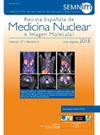18F-FDG PET/TC在评估骨关节感染和炎症中的作用和应用——第一部分
IF 1.6
4区 医学
Q3 RADIOLOGY, NUCLEAR MEDICINE & MEDICAL IMAGING
Revista Espanola De Medicina Nuclear E Imagen Molecular
Pub Date : 2025-01-01
DOI:10.1016/j.remn.2024.500073
引用次数: 0
摘要
随着时间的推移,18F-FDG PET/CT已被定位为评估骨关节感染的有用工具,在某些适应症中克服了MRI或骨显像等传统探索。其同时提供功能和解剖图像的能力及其出色的分辨率有助于更精确和个性化的方法治疗骨关节疾病,如脊柱炎。此外,它已被证明对诊断或治疗复杂的疑似感染患者有价值,提高了亚临床阶段的检测。然而,已经发现了一些局限性,例如感染与炎症(如糖尿病足)的鉴别诊断困难,或者对有骨合成材料的患者的解释困难。在这篇文章中,我们简要回顾了18F-FDG PET/CT在感染性骨关节病理中的作用,提供了一般和实用的信息,而第2部分讨论了18F-FDG PET/CT在骨关节炎症中的作用。本文章由计算机程序翻译,如有差异,请以英文原文为准。
Papel y aplicaciones de la 18F-FDG PET/TC en la evaluación de la infección e inflamación osteoarticular - Parte I
18F-FDG PET/CT has been positioned over time as a useful tool in the evaluation of osteoarticular infections, overcoming conventional explorations like MRI or bone scintigraphy in some indications. Its ability to provide functional and anatomical images simultaneously and its excellent resolution contributes to a more precise and personalised approach in the treatment of osteoarticular diseases such as spondylodiscitis. In addition, it has proven valuable in patients with suspected infection that is complex to diagnose or treat, improving detection in subclinical stages. However, some limitations have been identified, such as difficulty in the differential diagnosis of infection vs. inflammation (as in diabetic foot) or in the interpretation of patients with osteosynthesis materials. In this manuscript, we present a brief review providing general and practical information about the role of 18F-FDG PET/CT in infectious osteoarticular pathology, while part 2 discusses the role of 18F-FDG PET/CT in osteoarticular inflammation.
求助全文
通过发布文献求助,成功后即可免费获取论文全文。
去求助
来源期刊

Revista Espanola De Medicina Nuclear E Imagen Molecular
RADIOLOGY, NUCLEAR MEDICINE & MEDICAL IMAGING-
CiteScore
1.10
自引率
16.70%
发文量
85
审稿时长
24 days
期刊介绍:
The Revista Española de Medicina Nuclear e Imagen Molecular (Spanish Journal of Nuclear Medicine and Molecular Imaging), was founded in 1982, and is the official journal of the Spanish Society of Nuclear Medicine and Molecular Imaging, which has more than 700 members.
The Journal, which publishes 6 regular issues per year, has the promotion of research and continuing education in all fields of Nuclear Medicine as its main aim. For this, its principal sections are Originals, Clinical Notes, Images of Interest, and Special Collaboration articles.
 求助内容:
求助内容: 应助结果提醒方式:
应助结果提醒方式:


